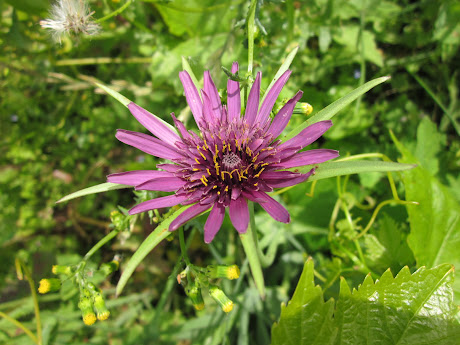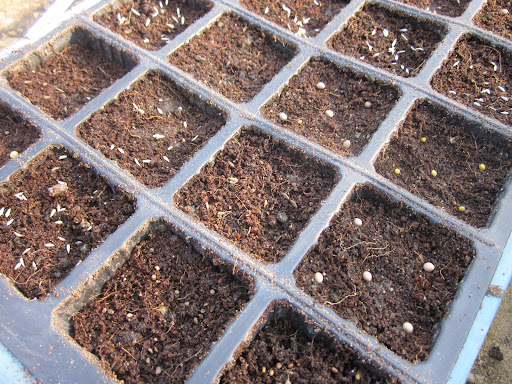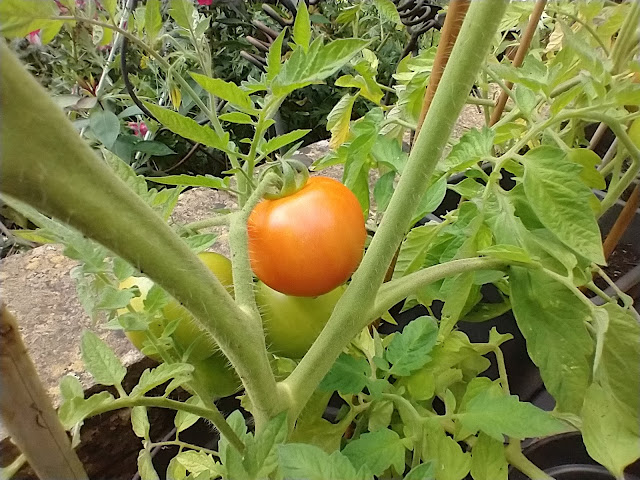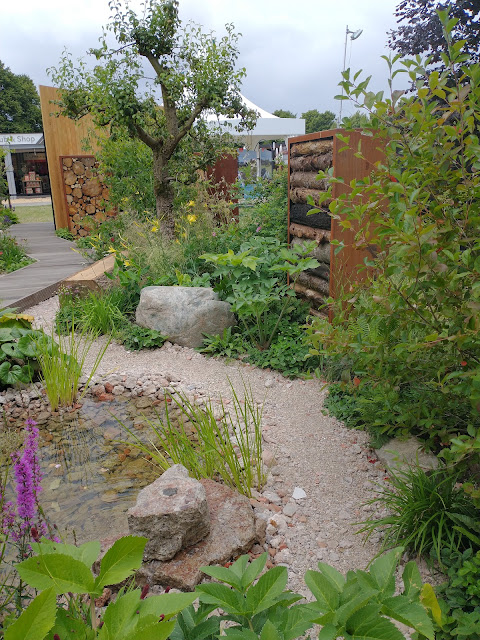Some Thoughts on #TheDress and Gardening
 |
| Keith Wiley's colourful garden at Wildside on a rainy day in July. It's here I learned the importance of how green can provide balance in a colour scheme. |
A photograph of blue and black dress which looked gold and white to some caused a storm of controversy and a top trending #TheDress hashtag across social media last week. It even made the national news.
I put my thoughts to one side on how camera and computer settings, plus viewing angles can alter what we see, and had a think about the use of colour in our gardens.
My interest in this subject started not long after I'd met Threadspider. We were looking at a piece of turquoise cloth one day, which she clearly saw as green and I as blue. In that instant I realised how a simple difference in our eyes could alter our perception of the world. This was also discussed in relation to #TheDress, particularly how the number of cones * in the eye's structure can alter the range of colours we can see.
Apparently Christopher Lloyd was colour blind ** and he was often criticised for his combination of particular shades of pink and yellow at Great Dixter. I wonder how much his colour blindness altered what he saw in that combination. I hope it wasn't as drastic as it was for my red-green colour blind colleague, who always saw my pink and yellow checked dress as a muddy brown.
Over the years I've learned to keep any criticism at bay whenever I flinch at what I see as a particularly gaudy colour scheme, or the use of a colour I don't particularly like. After all, who's to say I'm right?
* = if anyone has a better written article on this subject, let me know. For example, the remarks about bees aren't accurate, and the accuracy of the online test shown can be affected by computer settings, but the general points made in this article are valid.
** = thanks to Catherine Horwood for the information.
You may also like:
I wrote about Colour Theory in Garden Design for BBC Gardening many moons ago. I realised then just how vast this subject is and how many factors affect what each of us sees. They include: our education; what's in fashion; our cultural background; the impact of light, the weather and seasons; where we are in the world; our mood and other psychological factors; our experiences; our age; and a whole host of other things. It's endlessly fascinating and I'd love to make a full study of it sometime.










great
ReplyDeleteThanks
DeleteI've long wondered whether we all process colours in the same way. As a young child we are taught the names of colours by being shown a colour and repeating its name, but do we all see the same colour when we point and say blue? Is what I see as blue what someone else sees as red. I always thought a table of green at school must be so confusing as the tints and shades of greens are vastly different.
ReplyDeleteBy the way I saw blue and gold.
Isn't it interesting? The role of education plays is tremendous - who's to say that the object you saw really was red and it was the teacher's eyes only which saw it as green? Colours are so variable, so many of them can be seen with hues from other colours - the turquoise in my example is notorious for that. Artists understand the concept well as they are used to mixing colours made from others.
DeleteI wonder if it's possible to make a garden which clashes in colour, just from green plants? Perhaps that's one of the reasons why some people dislike variegated plants?
without a doubt of a shadow. There'd never be any relief ... as the 'flowers' faded!
DeleteYes as an artist I agree about mixing colours and colour perception or learning a colour by a name, the result is very varied, we don't all see the same things, try asking a bunch of artists or designers to describe' terracotta' , almost impossible.
ReplyDeleteThanks Meryl - since writing this post I've tried to imagine describing colours to someone for the first time and failed!
DeleteWhat fascinates me is, if you saw something as blue, and Threadspider saw it as green, how did you know it was turquoise? And was it turquoise? I'm sure we're not all seeing the same thing.
ReplyDeleteHowever, it's also down to language. Did you see a TV programme not so long ago which looked at language and colour? They visited a tribe somewhere in Africa who could see differences in colours (greens, I think, but might have been browns) that, to most of us, looked all the same, and, crucially, had names for them. Equally, as far as I remember, we had words for colours that to them looked no different. If you can't describe something, to an extent it doesn't exist.
I wish I'd seen that programme Helen, it sounds fascinating. I seem to remember a similar story about a people who didn't see a sailing ship when it weighed anchor in a bay because they hadn't seen one before and therefore didn't have the means to comprehend what they saw.
DeleteI saw all the photos of the infamous dress on Facebook, but didn't bother to read the articles explaining it. Then yesterday the woman and her daughter who posted the original photo were on "Ellen," and she was wearing the dress--which is definitely blue and black! Now I'm curious to understand why I thought it was gold and white. As for color in the garden, I plant what I like and don't worry whether it harmonizes anymore. I do gravitate toward pastels, though--I wonder what that says about me?
ReplyDeleteRose - I'm with you on planting what I like and worrying about it. That's all we can do with our own gardens isn't it?
DeleteI can remember many years ago, helping to paint the outside of our church. At the end, we cleaned our brushes, but the man next to me wiped his on the grass. We had been using brown paint and he couldn't see any difference between the green grass and the paint on his brush. I think we all see things differently.
ReplyDeleteThat's an amazing story Pauline!
Delete